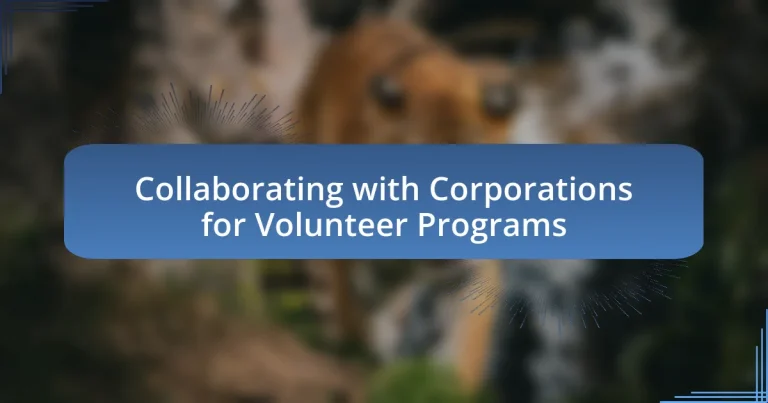Collaborating with corporations for volunteer programs involves partnerships between nonprofit organizations and businesses aimed at enhancing employee engagement in community service. This article explores the functioning of these collaborations, highlighting key elements for success such as alignment of values, effective communication, and measurable impact. It also examines the motivations behind corporate involvement in volunteerism, the challenges faced, and strategies for overcoming these obstacles. Additionally, the article discusses how corporations can assess the effectiveness of their volunteer initiatives and the emerging trends shaping corporate volunteer strategies, including the influence of technology and social issues.

What is Collaborating with Corporations for Volunteer Programs?
Collaborating with corporations for volunteer programs involves partnerships between nonprofit organizations and businesses to facilitate employee engagement in community service. This collaboration allows corporations to leverage their resources, such as funding, expertise, and employee time, to support various social causes. For instance, a study by the Corporation for National and Community Service found that companies with volunteer programs report higher employee satisfaction and retention rates, demonstrating the mutual benefits of such partnerships.
How does collaboration between corporations and volunteer programs function?
Collaboration between corporations and volunteer programs functions through strategic partnerships that align corporate social responsibility (CSR) goals with community needs. Corporations often provide financial support, employee volunteers, and resources to enhance the effectiveness of volunteer programs, while volunteer organizations offer expertise in community engagement and program implementation. For example, a study by the Points of Light Foundation found that 70% of companies reported increased employee engagement when involved in volunteer initiatives, demonstrating the mutual benefits of such collaborations. This synergy not only addresses social issues but also enhances corporate reputation and employee morale.
What are the key elements of successful corporate volunteer collaborations?
Successful corporate volunteer collaborations hinge on three key elements: alignment of values, effective communication, and measurable impact. Alignment of values ensures that the corporate partner’s mission resonates with the volunteer program’s goals, fostering genuine engagement. Effective communication facilitates clear expectations and fosters a collaborative environment, which is essential for addressing challenges and celebrating successes. Measurable impact allows organizations to assess the effectiveness of their volunteer efforts, demonstrating value to both the corporation and the community. Research indicates that companies with strong volunteer programs report higher employee satisfaction and retention rates, reinforcing the importance of these elements in achieving successful collaborations.
How do corporations identify suitable volunteer programs to partner with?
Corporations identify suitable volunteer programs to partner with by assessing alignment with their corporate values and community needs. They conduct research to evaluate potential programs based on criteria such as mission compatibility, impact metrics, and community engagement. For instance, a corporation may analyze a program’s previous outcomes, volunteer satisfaction rates, and the demographic it serves to ensure it resonates with their brand identity and social responsibility goals. This strategic approach not only enhances the effectiveness of their partnerships but also fosters a positive corporate image and community relations.
What are the motivations behind corporations collaborating with volunteer programs?
Corporations collaborate with volunteer programs primarily to enhance their corporate social responsibility (CSR) initiatives. This collaboration allows companies to improve their public image, foster employee engagement, and contribute positively to the community. For instance, a study by Cone Communications found that 70% of employees feel more engaged when their employer supports volunteer efforts, indicating that such collaborations can lead to increased employee satisfaction and retention. Additionally, companies often seek to align their brand values with social causes, which can attract customers who prioritize ethical consumption.
Why do corporations seek to enhance their corporate social responsibility through volunteerism?
Corporations seek to enhance their corporate social responsibility (CSR) through volunteerism to improve their public image and foster employee engagement. By participating in volunteer activities, companies demonstrate a commitment to social and environmental issues, which can enhance brand reputation and customer loyalty. Research indicates that 70% of consumers are more likely to purchase from a company that supports social causes, highlighting the direct correlation between CSR initiatives and consumer behavior. Additionally, volunteerism can lead to increased employee satisfaction and retention, as employees often feel more motivated and connected to their organization when involved in meaningful community service.
How does employee engagement influence corporate volunteer initiatives?
Employee engagement significantly enhances corporate volunteer initiatives by fostering a sense of ownership and commitment among employees. Engaged employees are more likely to participate actively in volunteer programs, as they feel a connection to their organization’s values and mission. Research indicates that companies with high employee engagement levels see a 20% increase in participation rates in volunteer activities, which can lead to improved community relations and a stronger corporate reputation. Furthermore, engaged employees often advocate for volunteer initiatives, driving higher involvement and creating a culture of service within the organization.
What challenges do corporations face when collaborating with volunteer programs?
Corporations face several challenges when collaborating with volunteer programs, including alignment of goals, resource allocation, and measuring impact. Misalignment occurs when corporate objectives do not match the mission of the volunteer program, leading to ineffective partnerships. Resource allocation challenges arise as corporations must balance their operational needs with the time and financial investment required for volunteer initiatives. Additionally, measuring the impact of volunteer efforts can be difficult, as quantifying social benefits and return on investment is often complex and subjective. These challenges can hinder the effectiveness and sustainability of corporate volunteer collaborations.
What are common barriers to effective collaboration?
Common barriers to effective collaboration include communication issues, differing organizational cultures, and lack of clear goals. Communication issues arise when team members do not share information effectively, leading to misunderstandings and misalignment. Differing organizational cultures can create friction, as varying values and practices may hinder cooperation. Lack of clear goals results in confusion about objectives, making it difficult for teams to work together efficiently. These barriers are supported by research indicating that effective communication and shared objectives are critical for successful collaboration in volunteer programs.
How can corporations overcome these challenges to ensure successful partnerships?
Corporations can overcome challenges to ensure successful partnerships by establishing clear communication and shared goals. Effective communication fosters transparency and trust, which are essential for collaboration. For instance, a study by the Harvard Business Review found that organizations with aligned objectives and open dialogue are 30% more likely to achieve successful partnerships. Additionally, corporations should invest in relationship management strategies, such as regular check-ins and feedback mechanisms, to address issues proactively and adapt to changing circumstances. This approach not only strengthens partnerships but also enhances the overall impact of volunteer programs.
How can corporations measure the impact of their volunteer programs?
Corporations can measure the impact of their volunteer programs by utilizing metrics such as employee engagement levels, community feedback, and social return on investment (SROI). Employee engagement can be assessed through surveys that gauge satisfaction and morale before and after participation in volunteer activities, revealing the program’s influence on workplace culture. Community feedback can be gathered through direct surveys or interviews with beneficiaries, providing qualitative data on the program’s effectiveness in addressing community needs. Additionally, SROI calculations can quantify the economic value generated by volunteer efforts, comparing the costs of the program to the benefits realized by the community, thus offering a clear financial perspective on the program’s impact.
What metrics are most effective for assessing the success of volunteer collaborations?
The most effective metrics for assessing the success of volunteer collaborations include volunteer retention rates, the number of volunteer hours contributed, and the impact on community outcomes. Volunteer retention rates indicate how many volunteers continue to participate over time, reflecting satisfaction and engagement. The total number of volunteer hours provides a quantitative measure of commitment and resource allocation. Additionally, evaluating community outcomes, such as improvements in local services or increased community engagement, demonstrates the tangible effects of volunteer efforts. These metrics collectively offer a comprehensive view of the effectiveness and impact of volunteer collaborations.
How can feedback from participants enhance future volunteer initiatives?
Feedback from participants can enhance future volunteer initiatives by providing insights into their experiences, preferences, and suggestions for improvement. This information allows organizations to tailor programs to better meet the needs of volunteers, thereby increasing engagement and satisfaction. For instance, a study by the Corporation for National and Community Service found that organizations that actively seek and implement volunteer feedback see a 20% increase in volunteer retention rates. By analyzing participant feedback, organizations can identify successful strategies and areas needing improvement, leading to more effective and impactful volunteer programs.
What best practices should corporations follow when engaging in volunteer collaborations?
Corporations should prioritize clear communication and alignment of goals when engaging in volunteer collaborations. Establishing mutual objectives ensures that both the corporation and the partnering organization understand the desired outcomes, which enhances the effectiveness of the collaboration. Additionally, corporations should provide adequate training and resources to volunteers, as studies show that well-prepared volunteers are more likely to have a positive impact on the community and the organization. Furthermore, measuring and evaluating the impact of volunteer efforts is essential; research indicates that organizations that assess their volunteer programs can identify areas for improvement and demonstrate the value of their contributions. Lastly, fostering a culture of recognition and appreciation for volunteers can enhance engagement and retention, as evidenced by surveys indicating that recognition significantly boosts volunteer satisfaction and commitment.
How can corporations effectively communicate their volunteer goals to employees?
Corporations can effectively communicate their volunteer goals to employees by utilizing clear messaging through multiple channels, such as internal newsletters, meetings, and digital platforms. This approach ensures that all employees receive consistent information about the company’s volunteer initiatives, fostering engagement and participation. Research indicates that organizations with structured communication strategies see a 25% increase in employee involvement in volunteer programs, highlighting the importance of clarity and accessibility in messaging.
What strategies can enhance the sustainability of corporate volunteer programs?
To enhance the sustainability of corporate volunteer programs, organizations should implement strategies such as aligning volunteer initiatives with corporate values, fostering employee engagement, and establishing long-term partnerships with community organizations. Aligning volunteer efforts with corporate values ensures that employees feel a sense of purpose and connection to the work they are doing, which can lead to increased participation and commitment. Fostering employee engagement through regular feedback and recognition can also enhance motivation and retention in volunteer programs. Additionally, establishing long-term partnerships with community organizations allows for more impactful and sustained contributions, as these relationships can lead to ongoing projects that benefit both the community and the corporation. Research indicates that companies with strong volunteer programs see a 50% increase in employee retention, demonstrating the effectiveness of these strategies in promoting sustainability.
What are the future trends in corporate volunteer collaborations?
Future trends in corporate volunteer collaborations include increased focus on employee engagement, integration of technology, and alignment with corporate social responsibility (CSR) goals. Companies are prioritizing volunteer programs that enhance employee satisfaction and retention, as studies show that engaged employees are 17% more productive. Additionally, the use of digital platforms for organizing and tracking volunteer efforts is on the rise, facilitating better communication and participation. Furthermore, corporations are increasingly aligning their volunteer initiatives with their CSR objectives, ensuring that community impact is measurable and relevant to their business strategies. This trend is supported by research indicating that 70% of employees prefer to work for companies that demonstrate a commitment to social responsibility.
How is technology shaping the landscape of corporate volunteerism?
Technology is significantly shaping the landscape of corporate volunteerism by enhancing engagement, streamlining coordination, and measuring impact. Digital platforms enable companies to connect employees with volunteer opportunities that align with their skills and interests, fostering a more personalized experience. For instance, organizations like Benevity and VolunteerMatch provide software solutions that facilitate the matching process, making it easier for employees to find and participate in community service projects. Additionally, technology allows for real-time tracking of volunteer hours and contributions, which helps companies assess the social impact of their initiatives. According to a 2021 report by the Points of Light Foundation, 70% of companies using technology for volunteer management reported increased employee participation in volunteer programs, demonstrating the effectiveness of these tools in promoting corporate social responsibility.
What emerging social issues are influencing corporate volunteer strategies?
Emerging social issues influencing corporate volunteer strategies include social justice, environmental sustainability, and mental health awareness. Companies are increasingly aligning their volunteer initiatives with social justice movements, such as racial equality and gender equity, to demonstrate corporate responsibility and engage employees who prioritize these values. Additionally, the growing emphasis on environmental sustainability drives corporations to participate in volunteer programs focused on conservation and climate action, reflecting a commitment to corporate social responsibility. Mental health awareness has also gained traction, prompting organizations to support volunteer efforts that promote mental well-being and community support systems. These trends are supported by research indicating that 70% of employees prefer to work for companies that contribute to social causes, highlighting the importance of aligning corporate volunteer strategies with these emerging social issues.
What practical tips can corporations implement for successful volunteer collaborations?
Corporations can implement structured planning and clear communication for successful volunteer collaborations. Establishing defined goals and expectations ensures that all parties understand their roles and contributions. For instance, a study by the Corporation for National and Community Service found that organizations with clear objectives for volunteer engagement saw a 50% increase in volunteer retention rates. Additionally, providing training and resources equips volunteers with the necessary skills, enhancing their effectiveness and satisfaction. Regular feedback mechanisms can also improve collaboration by allowing corporations to adjust strategies based on volunteer experiences and outcomes.


